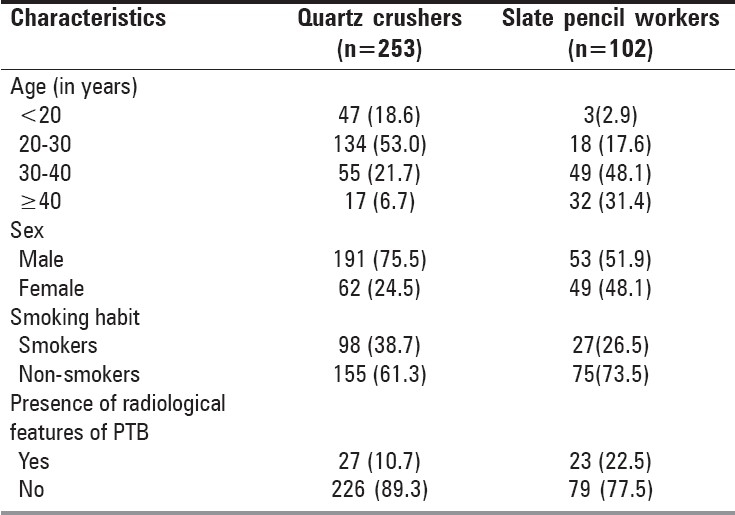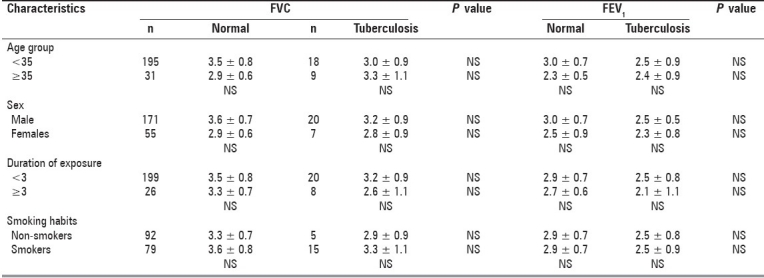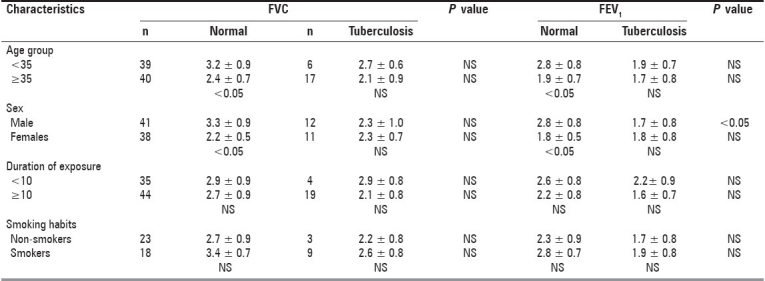Abstract
Tuberculosis (TB) is a global emergency. Poverty, increasing migration, homelessness and the compulsions to live and work in high-risk environments are making people increasingly susceptible to the disease. Those working in mines, construction work, stone-crushing and in other similar occupations where there is a greater level of exposure to silica dust are specially vulnerable. Though the association between TB and silicosis has been firmly established by the results of epidemiologic studies no attempts have been made to study the epidemiological features of radiologically active TB among free silica exposed workers. Thus the cross sectional study was carried out among slate pencil workers and quartz stone crushers to assess the prevalence of TB and some associated epidemiological factors. It included 253 quartz workers and 102 slate pencil workers. Clinical history and chest radiographs were used for labeling the subjects as tuberculotic. The pulmonary functions of the subjects were measured using Spirovit SP- 10. Statistical analysis was carried out using statistical software package Epi Info 3.3.2. Among stone crushers the prevalence of TB was found to be 10.7% while among slate pencil workers it was as high as 22.5%. Among the quartz stone-crushers the workers aged ≥35 years, those exposed for ≥3 years and those who were smokers had higher risk TB while among the slate pencil workers, only those exposed for ≥10 years had higher risk. Though the FVC and FEV1 values of the workers having TB were lower than those having normal radiographs, the differences were found to statistically non-significant.
Keywords: FEV1, free silica, FVC, tuberculosis
INTRODUCTION
Tuberculosis (TB) is a global emergency. Nearly two million people die every year from tuberculosis[1] and despite National Tuberculosis Control Programmes operating in many countries; eight and a half million new cases appear each year to challenge public health. The South-East Asia region bears the major brunt of the global TB burden harboring 38% of the world's TB cases. Poverty, increasing migration, homelessness and the compulsions to live and work in high-risk environments are making people increasingly susceptible to the disease. Each year the region sees three million new cases and loses 750 000 lives due to tuberculosis.[1]
The industrial sector bears a heavy load of these losses. In many workplaces, employees operate in closed spaces and unprotected environments, which carry high risk of the disease spreading from those having active TB to other employees working in close proximity. Those working in mines, construction work, stone crushing and in other similar occupations where there is a greater level of exposure to silica dust are also specially vulnerable.
The association between TB and silicosis has been firmly established by the results of epidemiologic studies.[2–7] However no attempts have been made to study the epidemiological features of radiologically active TB among free silica exposed workers. Thus with this objective the present study was carried out among slate pencil workers and quartz stone crushers to assess the prevalence of TB and some associated epidemiological factors.
MATERIALS AND METHODS
The present study was designed as a cross sectional study. 253 quartz workers and 102 slate pencil workers were included in the study. The quartz workers were working in the quartz crushing units of Godhara while the slate pencil workers were working at cottage industries of Mandsaur. Using interview technique as a tool for data collection demographic and occupational details of the subjects were recorded on the pre-designed proforma. Clinical history and chest radiographs were used for labeling the subjects as tuberculotic. The pulmonary functions of the subjects were measured using Spirovit SP-10 (Maker Schiller AG, Switzerland). After calibrating the spirometer according to the procedure given in the catalog, three readings of each ventilatory function of each subject were taken. The readings showing the highest value were recorded considering that the subject has co-operated at his/her best and used for further analysis. Statistical analysis was carried out using statistical software package Epi Info 3.3.2 and included calculation of proportion and percentages, application of tests of significance such as t-test, Chi square test and calculation of odds ratio with its 95% confidence intervals.
RESULTS
Table 1 shows the demographic characteristics of the subjects included in the present study. Out of 253 quartz stone workers 191 (75.5%) were male while 62 (24.5%) were female while of 102 slate pencil workers 53 (51.9%) were male and 49 (48.1%) were females. The mean age of the quartz stone workers was 28.0 ± 7.9 years while that of slate pencil workers was 39.1 ± 10.0 years. The mean duration of exposure was 1.8 ± 0.2 and 15.3 ± 0.7 years for quartz stone workers and slate pencil workers respectively. The prevalence of TB was found to be 10.7% among quartz stone workers while among slate pencil workers it was 22.5%.
Table 1.
Distribution of study subjects according to demographic characteristics

Table 2 shows the distribution of TB cases according to study variables among the quartz stone workers. It can be seen that those aged ≥35 years and those employed for ≥3 years had higher prevalence of TB. Also the males who were smokers had significantly higher prevalence of TB. Similarly, those aged ≥35 years, having duration of employment ≥3 years and were smokers had higher risk of development of TB.
Table 2.
Tuberculosis according to various epidemiological factors among quartz workers

Table 3 shows the distribution of TB cases according to study variables among the slate pencil workers. It can be seen that those employed for ≥10 years had higher prevalence of TB as well as higher risk of development of TB.
Table 3.
Tuberculosis according to various epidemiological factors among slate pencil workers

Table 4 describes the forced vital capacity (FVC) and forced expiratory volume in first second (FEV1) among quartz workers according to the different study variables. It can be observed that the FVC and FEV1 values are lower among subjects with tuberculosis as compared to those having normal radiograph. However the difference is statistically non-significant.
Table 4.
FVC and FEV1 among quartz crushers according to study parameters

Table 5 describes the FVC and FEV1 among slate pencil workers according to the different study variables. In this case also the difference in the values of FVC and FEV1 among tuberculotics and normal subjects was statistically non- significant. However the FEV1 levels of tuberculotic males was significantly lower than the normal males. This can be attributed to the smoking habits of these males.
Table 5.
FVC and FEV1 among slate pencil workers according to study parameters

DISCUSSION
In the present study two cottage industries where free silica exposure is present were included. The radiologically active TB was found to be 10.7% among quartz workers while among slate pencil workers it was found to be 22.5%. This prevalence was much higher for the all India prevalence of radiologicaly active TB, which is 16 per 1000 population.[8] Secondly this is underestimation of actual prevalence as those having TB along with silicosis were excluded from the analysis so as to negate the effect of silicosis on lung function tests. This suggest that exposure to free silica increases the susceptibility for TB. In earlier epidemiologic studies the association between TB and silicosis has been firmly established.[2–7] Some evidence indicates that workers who do not have silicosis but who have had long exposures to silica dust may be at increased risk of developing TB.[5,6]
In the present study though the sputum acid-fast bacilli (AFB) smear examination of these subjects could not be done, the earlier studies have shown that only half of the mycobacterial infections that occur in workers with exposure to silica are caused by M. tuberculosis and the other half are caused by the non-tuberculous mycobacteria (NTM) Mycobacterium kansasii and Mycobacterium avium-intracellulare.[9–11]
The cause of aggravation of TB in dust-exposed people is still unclear. Most probably the defense mechanisms of the lung are impeded by massive dust deposits, particularly by blocking the lymph drainage and thus hindering the elimination of invaded bacteria. Furthermore, the high prevalence of TB in dust-exposed people is probably caused by alteration of the macrophages due to the combined effects of both noxae. Free silica reduces the ability of macrophages to stop the growth of tubercle bacteria.[12]
Among the quartz stone crushers the workers aged ≥35 years, those exposed for ≥3 years and those who were smokers had higher risk TB. This may be attributed to the increased cumulative exposure to free silica dust. However among the slate pencil workers, only those exposed for ≥10 years had higher risk. The pulmonary function of the workers having tuberculosis was also found to be deteriorated. However due to lack of sufficient sample size after dichotomization of variables, the differences was found to statistically non-significant.
Thus the present study suggests higher prevalence of tuberculosis among free silica exposed workers. Also, the duration of exposure is an important epidemiological factor responsible for this increased risk. However there are certain limitations in this study. The cohort study design would have been a better study design to demonstrate the cause effect association. However as the main objective was to put forward the hypothesis among these two groups of cottage industries, the cross sectional study design was adopted. Secondly, the small sample size of the study limits the generalization of results. Thirdly as the diagnosis of TB is purely on the basis of clinical examination and chest radiography and sputum AFB was not carried out, it does not help in the control of transmission of the infection. Thus a more elaborate study with larger sample size is recommended.
Footnotes
Source of Support: Nil
Conflict of Interest: None declared.
REFERENCES
- 1.DOTS at the workplace. New Delhi: World Health Organization; 2003. WHO; pp. 1–5. [Google Scholar]
- 2.Balmes J. Silica exposure and tuberculosis: An old problem with some new twists. J Occup Med. 1990;32:114–5. [PubMed] [Google Scholar]
- 3.Althouse RB, Bang KM, Castellan RM. Tuberculosis co-mortality with silicosis-United States, 1979-1991. Appl Occup Environ Hyg. 1995;10:1037–41. [Google Scholar]
- 4.Goldsmith DF, Beaumont JJ, Morrin LA, Schenker MB. Respiratory cancer and other chronic disease mortality among silicotics in California. Am J Ind Med. 1995;28:459–67. doi: 10.1002/ajim.4700280403. [DOI] [PubMed] [Google Scholar]
- 5.Cowie RL. The epidemiology of tuberculosis in gold miners with silicosis. Am J Respir Crit Care Med. 1994;150:1460–2. doi: 10.1164/ajrccm.150.5.7952577. [DOI] [PubMed] [Google Scholar]
- 6.Sherson D, Lander F. Morbidity of pulmonary tuberculosis among silicotic and non-silicotic foundry workers in Denmark. J Occup Med. 1990;32:110–3. [PubMed] [Google Scholar]
- 7.Kleinschmidt I, Churchyard G. Variation in incidences of tuberculosis in subgroups of South African gold miners. Occup Environ Med. 1997;54:636–41. doi: 10.1136/oem.54.9.636. [DOI] [PMC free article] [PubMed] [Google Scholar]
- 8.Chakraborty AK. Epidemiology of tuberculosis. Indian J Med Res. 2004;120:248–76. [PubMed] [Google Scholar]
- 9.Owens MW, Kinasewitz GT, Gonzalez E. Sandblaster's lung with mycobacterial infection. Am J Med Sci. 1988;295:554–7. doi: 10.1097/00000441-198806000-00010. [DOI] [PubMed] [Google Scholar]
- 10.Cincinnati, OH: U.S. Department of Health and Human Services, Public Health Service, Centers for Disease Control and Prevention, National Institute for Occupational Safety and Health, DHHS (NIOSH) Publication No. 96-112; NIOSH [1996b]. NIOSH alert: Request for assistance in preventing silicosis and deaths in construction workers. [Google Scholar]
- 11.Bailey WC, Brown M, Buechner HA, Weill H, Ichinose H, Ziskind M. Silico-mycobaterial disease in sandblasters. Am Rev Respir Dis. 1974;110:115–25. doi: 10.1164/arrd.1974.110.2.115. [DOI] [PubMed] [Google Scholar]
- 12.ILO. Encyclopaedia of Occupational Health. International Labour Organization: Geneva. 1986:2041. [Google Scholar]


